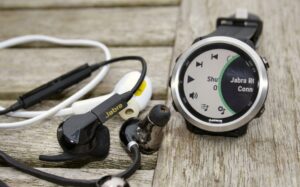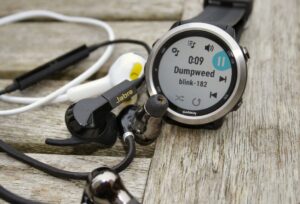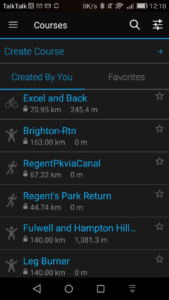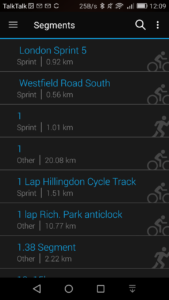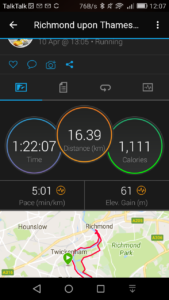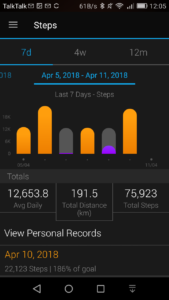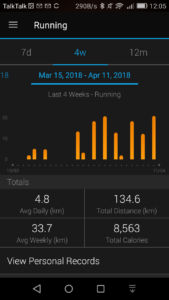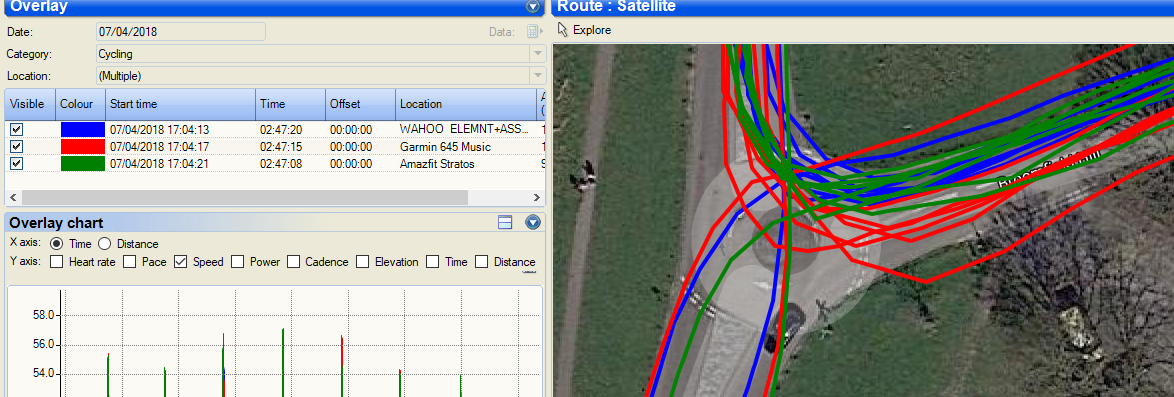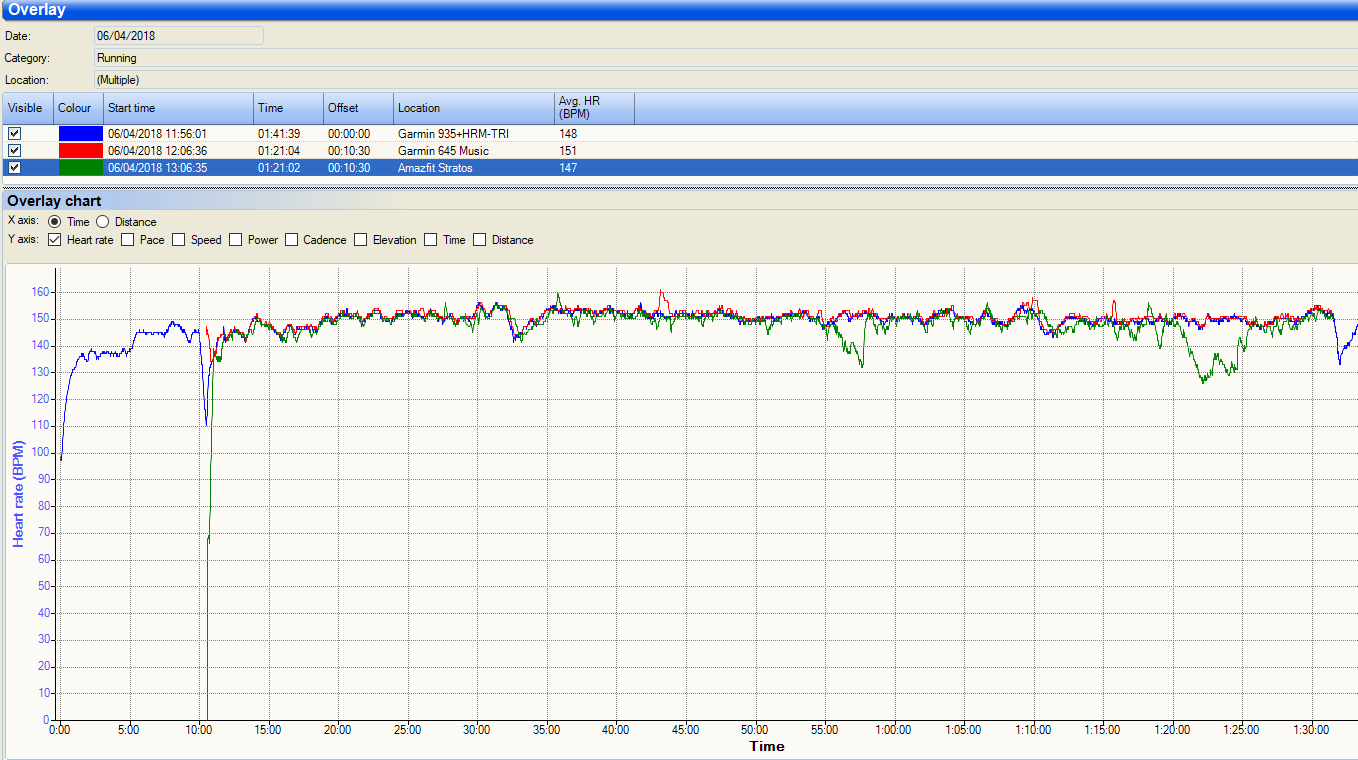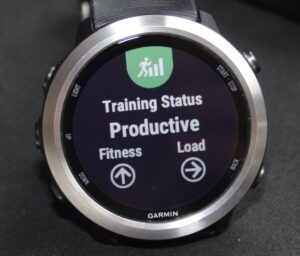In this detailed Garmin 645 Review, we take a look at Garmin’s latest, and potentially greatest, Forerunner running watch. Here’s a quick summary and below that is the full review.
In Brief
-
Value For Money - 85%
85%
-
Apparent Accuracy - 85%
85%
-
Build Quality & Design - 90%
90%
-
Features, Including App - 95%
95%
-
Openness & Compatability - 95%
95%
Summary
 In this Garmin 645 Review we have found, once again, that Garmin have produced a most amazingly complete Forerunner watch full of every imaginable option.
In this Garmin 645 Review we have found, once again, that Garmin have produced a most amazingly complete Forerunner watch full of every imaginable option.
Once again the sensors (GPS, oHR) let the overall package down and should act as somewhat of a deterrent to non casual runners looking for an element of precision in their training. For those of you willing to augment the 645 with chest strap and footpod purchases then those inbuilt sensor issues will go away.
I’ve somewhat lamented the 645’s looks but aesthetics are a personal choice. Rest assured that your 645 will do LOTS of sporty things that watches of your friends can’t.
The key USPs for the 645 are the smaller size format and Music. If either of those factors are REALLY important to you then you will find it hard to beat the 645. These are the two factors that will make this device a success.
Garmin Pay in 2019 is much more practical if your bank is supported (mine is) and now that Spotify Music support is added all is good in the running vibes department.
My preference would still be for a 945 or a Fenix 5/5s/5X Plus but they are much more expensive models. I would CERTAINLY recommend the 645 over a Fenix 5 NON-plus model
Pros
- The slightly smaller case format is NOT at the expense of screen resolution. This size will appeal to many.
- Spotify support is a big plus for many
- Garmin has the sport experience MOSTLY nailed.
- Many seem to like the metal bezel aesthetics (I don’t)
- The Firstbeat physiology stuff is amazing if you have the time to delve into it
Cons
- I’ve updated this for 2019 and the prices are now more sensible but the RRP is a bit steep IMHO
- Is your bank supported? Best check if you want Garmin PAY to work.
- Garmin Connect and the 645’s menus are a bit complex for a newcomer to Garmin.
- oHR accuracy CAN BE a bit of a worry and will mess up the physiology stats if not right. Accuracy varies by person 🙁
- GPS accuracy is ‘alright’…strange for a GPS company
- Battery life is good compared to the market but some of Garmin’s more expensive watches are even better in this respect.
 Garmin’s watches are so feature-full that sometimes it takes a special something to differentiate one model from another. As Garmin seeks to replace the ageing Forerunner 630 and add something different from the Vivoactive 3, the obvious and welcome addition was MUSIC.
Garmin’s watches are so feature-full that sometimes it takes a special something to differentiate one model from another. As Garmin seeks to replace the ageing Forerunner 630 and add something different from the Vivoactive 3, the obvious and welcome addition was MUSIC.
The Forerunner 645 also comes in a non-music version and, of course, there are many alternatives to the 645 as shown in the Best Running Watch with Music. So let’s properly inform you about all the pros and cons in this Garmin 645 Review. You’ll need a large coffee or use the Jump-To links to skip to the sections that interest you.
I’m a runner and I bought this myself. I have ZERO links to Garmin – no freebies, no PR loaners. I’m just like you ie a Garmin customer that runs a lot. Oh..except I do that wearing WAY too many gadgets 😉
In The Box
Yep, that’s it. A watch and a new charger that looks the same as the previous Forerunner charger…but isn’t. Lots of paper and, more noticeably, no headphones.
Your watch has standard, 20mm interchangeable bands and a built-in optical Heart Rate sensor…no need for an optional chest strap.
Of course, you also get the generally awesome and free Garmin Connect ecosystem online and on your smartphone.
Headline Differences – Detailed Differences
It’s likely that most of you will already be Garmin owners or will be actively considering one of Garmin’s high-end watches. You’ve probably already guessed that this watch has pretty much every Garmin running feature ever…plus Music. Here are the main differences that you might be considering in your research.
Sizing-Related Differences
It’s a small format watch. So for those of you with thin wrists and a love of running, you’re already looking in the right place.
It’s neither a large Garmin Fenix 5 nor a large Forerunner 935 tri watch. It’s smaller than the previous Forerunner watches which are also large 😉
Partly because of its the size, the 645 is also super light coming in at 42.2g.
However, the great thing with the 645 is that the small format design has NOT compromised on the screen size. Garmin has just made the bezel and wasted screen space smaller. Thus the 645 has an effective screen size of 1.2″ (30.4 mm) diameter or 240x240px which is the SAME as the Forerunner 935 and BETTER than the likes of the earlier 745XT/235/630 models.
Aesthetic Differences – Practical Differences
The 645 follows a recent trend with Garmin watches. They are moving away from a ‘sports-only’ look and towards a 24×7 watch that many people could wear for work. Partly this is a practical thing in that YOU might want to only wear one device to track your sleep, steps and sports. But from Garmin’s point of view, THEY don’t want you with another brand on your wrist reminding you of something else at different times of the day.
Personally, I want a sports-look watch for sports. You may be the same or different to me in that respect. Either way, Garmin’s call is probably the best financial move for them.
However I think that, for a premium watch, the 645’s brushed stainless steel bezel looks a cheap.
The display resolution, whilst an improvement on previous models, is still poor compared to the Apple Watch or the Fitbit Ionic/Versa or the WearOS watches that you will see other people wearing. The 645 simply doesn’t look as good. To me, that does not sit well against the premium price tag.

HOWEVER there ARE good reasons for this aesthetic. The longevity of the bezel for one. But, perhaps more importantly, the lower resolution display will mean that the battery lasts WAY longer than the devices I mentioned in the previous paragraph. It’s no good having a beautiful Apple Watch 3 if the already part-depleted battery runs out half way through your run. Those other watches are beautiful BATTERY EATERS. With the Garmin you will NOT have a battery problem that you can’t sensibly solve.
Then we come to the buttons. 5 of them. To cut to the chase: a proper, practical sports watch needs 5 buttons. Not 1 and a touchscreen like the Vivoactive 3. Not 3 and a touchscreen like a Suunto Spartan Sport. Not just a touchscreen. You’re buying a running watch for, ahem, running. It might be a toy for you as well but the 5 buttons are required for a running watch IMO – you could argue for 4 or 6 too. But not 3 or less.

Another big practical difference is that Garmin’s have fiendishly complex menu systems. You might want to do something. The watch can for sure, do it. But finding that place in the watch’s menu might be convoluted. But, set against that, you can ALWAYS do NEARLY ALL of the common tasks on the watch, some other devices require a paired smartphone to do that. You know? The one you left at home (or lost) when you went away for the weekend for that important race.
Whilst we are on the topic of the menu system. I don’t like the look of it. However, Garmin has honed it over recent product iterations and I have to say it works REALLY well. It’s generally been thought through well in a sporty-cum-ergonomic sense.
The music interface also doesn’t look great compared to other running watches with music. However, I’ve used quite a lot of those running+music watches now and I have to say that the Garmin interface works very well with music playback. Better than all the rest.
The charger is also uber-practical. You might think it would be sensible to have a generic micro USB port. And that WOULD be the case if you never got it wet, never sweated or never wiggled the USB cable around a bit…repeatedly. The clasp-on charger IS the best solution. Actually, an induction charger might be good but that’s a bit too flashy for my liking. You know where you are with a cable. Unless you lose it. Don’t lose it.
Garmin never released the expected Forerunner 635 ie an optical-enabled 630. They skipped to this version, the 645. Optical HR has turned out to be a bit hit-and-miss but you can get it on any of the latest Garmin and, as we shall see later, it might not be worth having for many of you taking sport seriously.
Music Differences for the Garmin 645 Music Review
It’s the only Garmin with music. I thought the Vivoactive 3 would have music when it was released last year…it didn’t. The Vivoactive 3 did have Garmin PAY but the intended target market for the Vivoactive, I would have assumed, would be perfect for Music. Maybe music will follow later on that device? Probably not.

There are several kinds of music modes of operation:
- The watch is a controller for your smartphone’s music. The headphone connects to your smartphone – the 645 Music does this
- The watch stores music and plays back music from the watch
- A simple copy of mp3 files onto the device – the 645 Music does this
- Syncing with computer software libraries like Windows music Player and iTunes – NOT the 645
- Syncing with computer-based or smartphone-based streaming services – the 645 Music does this, with caveats
- Tracks and playlists can be sync’d – the 645 Music does this
- The watch contains cellular connectivity and directly links to an online music service eg the Apple Watch 3 LTE to Apple Music – NOT the 645
Think of ‘link and sync‘ or think of ‘offline storage‘ if that helps understand the 645 Music for you. The KEY thing is that you leave the smartphone at home.
There are several other non-Garmin devices that have onboard music. I’ll talk more about MUSIC later in this review.
Payment System Difference
Like the Vivoactive 3, the Forerunner 645 comes with the fledgeling Garmin Pay payments system. No-one is quite sure yet if even the top-end Garmin Fenix 5 models will get this feature; although, IMO, they should do at some point in the future.
Garmin has to negotiate a deal with every single bank separately, it’s not simply a VISA or MASTERCARD thing. You could be waiting a long time for your bank to get onboard. I won’t list the supported banks here as they will be continually updated.
Here is the complete list for all countries updated periodically by Garmin: link to garmin.com
In a nutshell: Works well with Starling Bank (UK)
Apple is over a year ahead with watch-based payments. I even managed to get the Fitbit Ionic to work in 2017 at Starbucks.
Operating System Differences
I’m talking here about the operating system on the watch itself and the apps they support.

If you want to do ‘weird stuff’ or ‘clever stuff’ with your running watch then you may well need to rely on 3rd party apps for that. For Garmin you WILL need CIQ2.X, which the 645 and other recent Garmins have NOW. CIQ will generally do clever SPORTY stuff really well (see RunScribe image to the right)
For the weird stuff or non-sporty clever stuff then Apple wins with Google playing catch up.
Only you will know your weird or clever future needs, sporting or otherwise. 😉
Detailed, Techy Differences
I don’t want to clutter up this review any more than I need to. If you want to know the **detailed specs** compared to other Garmin models then look at these 2 posts which are also super-detailed:
- Forerunner 645 Music Vs Forerunner 735XT vs Forerunner 935
- Forerunner 645 Music Vs Forerunner 235 Vs Forerunner 630
For those of you who have a life 🙂 Here is a Techy Differences Summary: If you are thinking of upgrading from the 630 then these are highlights: Bluetooth Smart sensor support; latest CIQ 2.x support; FirstBeat Training Status (Load/Recovery); Firstbeat Lactate Threshold; HRV Stress app (finally!); STRAVA Live Segments; follows courses; adds sports like SUP, Ski, indoor pool, and some others. But you can get ALL of that on the Forerunner 935 as well. And the Forerunner 935 (or Fenix 5) will give you quite a bit more tri-related functionality. Oh, you can respond to text messages too on the 645.
SPOILER ALERT: KEY POINT COMING UP
The battery differences are, in some respects, worse with the 645 than with the 630/735XT/235. GPS+Music will take you down to 5 hours of battery life. But that’s probably an ‘honest’ 5 hours from Garmin and better, in reality, than what competing vendors achieve with GPS+Music. Without the Music and with GPS, the 645’s battery life will be a creditable 12-14 hours but that’s not as good as the 935/Fenix 5 devices.
From a running point of view I don’t think any of the additional features on the 645 are worth the upgrade from a Forerunner 630 unless you have a pressing ‘need’ in one of those new areas. From a latest, greatest gadget point of view…hey! just buy the 645 and have a great play. Better still, buy the 935 or Fenix 5 and play even more.
Sports Profiles & Usage
There are a lot of sports profiles and you can create a custom profile. On the whole, a new sports profile will simply enable/disable a sensor type eg cycling shouldn’t look for a footpod and indoor running shouldn’t look for GPS. Also, different data fields will be put on the screen eg cycling might show speed rather than pace. Different sports profiles might apply different algorithms to OHR, accelerometers and GPS. Certainly, a different algorithm is enabled when you choose pool swimming to detect your stroke.
Sports Profiles in the Garmin Forerunner 645 Music Review
This is NOT a multisport watch and there are no multisport profiles. Buy a 935 or Fenix instead if you ever plan to do a multisport event.
You can hide sports profiles or put often used profiles to the top of the list as a favourite.

The 645 can have autolap, alerts, segment alerts and you can even manually change how GPS is handled in each sport (off or with GLONASS).
Garmin’s sports profiles and how they are customised are not perfect. But they are not too far from perfect and certainly better than all other running watch vendors. Polar are slightly better in some respects.
POOL SWIM and STRENGTH sports profiles are noteworthy for some differences to the norm. The STRENGTH sport profile will enable rep counting and the POOL SWIM profile has many advanced swim-related features including stroke detection, special rest functionality and the ability to set custom pool lengths. I would say that Garmin’s stroke detection algorithms are the best in my experience (I’m a reasonable triathlon swimmer).
If you want to record your HR in water (chest strap only), have a dedicated Open Water swim mode or use a power meter in cycling then the 645 is not for you. Buy a 935 or Fenix 5.
Run Metrics
A LOT of metrics are pre-installed on the device and there are additional data fields you can get from Connect IQ.
Here are some of the ones on the device: (Last)Lap Time; Elapsed Time; Avg. Lap Time; (Lap) Distance; Last Lap Distance; (Current) Pace; Average Pace;LapPace; Last LapPace; Speed; Average Speed;(Last) Lap Speed; Maximum Speed; Vertical Speed; Heart Rate; Average HR; HR Zone; Aerobic TTE; Anaerobic TE; HR% Max; %HRR; Avg HR %Max;Average %HRR; Lap HR; Lap %HRR; Lap HR %Max; Tiem in Zone; (Avg.) Vertical Oscillation; (Avg) Vertical Ratio; Avg/Lap GCT; Avg/LAP Gct Balance; (Avg) Stride Length; (Avg/Lap) Cadence; Temperature; Avg Ascent; Avg Descent; Max/Min Ascent/Descent; Elevation; Total/Lap/Last Lap Ascent/Descent; Min/Max Elevation; GPS Elevation; Glide Ratio; Grade; Heading; GPS Heading; Compass Heading; Navigation fields; Muscle Oxygen Fields; Calories; Battery Level; Performance Condition; Laps; Sunrise/sunset; and Time of Day.
Sports Usage
Garmin have honed their craft over the last decade. They really have thought of EVERYTHING. Everything might not be included but they have thought of it AND included most of it. This is the most feature-full running watch available, although the 935 and Fenix 5 can effectively do much of the same.

Complex, custom, structured Workouts – Garmin have supported these for MANY years. You can initiate a simple interval session on your watch but Garmin wisely moves you online or to the app to create a more complex workout that might, for example, include pace or HR alerts.
Lactate Threshold Tests – A guided run test is provided. But your thresholds are also automatically calculated as you run and you are prompted when the 645 thinks you have reached a new threshold and you can accept it if you like.
Targets – You can run to a time and/or distance target OR a distance+pace target.
Activity Racing – You can race any activity created by anyone. But can you keep up to the second-by-second paces THEY achieved up the hills?
Training Calendar – To plan your workouts
Segments – Running segments are supported (not tested)

Navigation – You can navigate back to your start point if you are lost #Handy. You can follow a colour plotted course line as you navigate a previous route created by you or someone else. There is NO MAP. There is a direction indicator and off-course indicator.
Metronome – Hone your cadence with an annoying beeping metronome. 😉
CIQ Running power data fields and apps ARE supported from STRYD, RunScribe and Garmin’s own Garmin Running Power. However, RUNNING POWER is NOT yet properly integrated into any Garmin watch. Once this is agreed by the ANT+ organisation then Garmin and other vendors can implement it. What this means for you, for example, is that you do not have the on-watch features with running power that you might be able to with HR. For example, you can create HR alerts but you can’t create RUNNING POWER alerts…at least not in the same way.
Even the options to discard, save, resume (etc) at the end of your workout have now been thoroughly thought through making the best effort not to let you inadvertently delete the 3 hour workout you just created. There are even various automatic workout recovery actions that can happen in certain circumstances.
Other Usage
There are several ‘Other usages but let’s look at 3rd party CIQ apps. These are all essentially free and several are of dubious quality & usefulness. There are a few gems such as DWMAP (navigation, 540,586 downloads..ouch!!) and apps that support other 3rd party physical products eg STRYD.

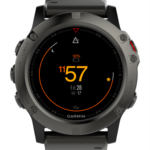
I only found one single watch face that I thought was aesthetically acceptable to me! And I was the 2nd person to download the aptly named FULL DAY, presumably 2nd after the author CLIV3RUN!. It’s up to exactly 6666 (8Jun2019) downloads now.
Sensors – Connectivity
You can pair sensors that are either Bluetooth SMART (BLE) or ANT+. YES!! This IS correct.
You can connect to the Garmin Connect app on either iOS or Android or to a computer via Garmin Express and the charging cable. Once you have paired to the app you can also automatically pair to WiFi networks that your smartphone is already paired to.
Much of the other interest in this section comes with what other sensors can be paired TO the Forerunner 645.
Headphones
Obviously, you can pair headphones to the Music version. I tried two pairs of Jabra headphones and a non-branded set and they all, superficially at, least paired. I do not know of any comprehensive list of headphones that work but try this for starters (Link to garmin.com). Note also that some headphone controls might not work when linked to the 645.
Speed &/or Cadence (Bike)

The classic Garmin GSC-10 combo sensors were the one to use a few years back. That’s still fine but it is a pain to switch between bikes so the new, more expensive and separate Garmin speed and cadence sensors are a great choice. Cheaper non-Garmin alternatives exist eg Wahoo.
Other than for indoor usage almost everyone will only need a cadence sensor. Getting your speed from GPS will be fine.
External Heart Rate
This could be a chest strap or arm band. I love the HRM-TRI as it offers additional features to the Fenix 5/935. The HRM-RUN would be a great option for you but there are many heart rate monitors at half of those prices that still give a perfectly good and accurate HR reading eg Wahoo, Polar, 4iiii, Scosche, Runar.

Most external chest straps provide HRV data. This is needed for Firstbeat LACTATE measurement. You can even store HRV data in the FIT file and then do some very, very clever & complex things afterwards. Not many of you will want to…
Footpod
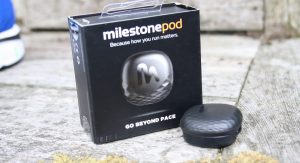
Once paired you might consider configuring the footpod on the 645 to be the source of PACE and DISTANCE.
I noticed no data dropouts in my limited work with STRYD and RunScribe.
RD-POD (Running Dynamics)

I’m not convinced that these sensors (and GPS) are sufficiently accurate inputs to give meaningful results in Garmin’s Running Power app. But it’s free, so give it a go.
Really I wouldn’t bother buying one of these. The metrics are not really actionable. You WILL get cadence from inside the watch and that IS accurate enough to be actionable AND cadence is the quickest win that most people can make to improve their technique. Basically…make cadence progressively higher over time; and lovely things fall into place, naturally.
Virb, Tempe, Lights, Radar, H.U.D. and Muscle O2

The onboard optical HR sensor can also re-broadcast your HR to other devices such as some gym equipment.
Garmin Connect App
Garmin’s app is one of the better sport and activity apps. I like Fitbit’s and Polar’s too.
The Garmin app is fully comprehensive: sleep, steps, sports, day views, trends, physiological stuff. It’s all there and more besides. The app is continually revamped and so it was recently. Continuing with a theme: I’m not so keen on the looks of the latest iteration and preferred the previous version’s looks! #Luddite
There is SO MUCH data in the app that sometimes it’s not always so intuitive to know where to look to find the information you need. But it is there. Somewhere.
All your data is sync’d to Garmin Connect online and the same sort of thing is available on that platform. And it’s all free.
Here are several screenshots of the app, including one of my GPS test route. More on that later.
Those of you who have more than one Garmin device will notice that your PBs and some other physiological recordings are NOT synchronised over the entire platform properly. This should be sorted out in 2018.
Music
If music be the food of running, play on, Give me excess of it; that suffering, The pace may slacken, and so die.
Source: W. Shakespeare (modified)
I wouldn’t go as far as dying Will, but lots of people do like to run with music and, by extension, podcasts. After all, an MP3 is an MP3 is an MP3.
First up: there’s no speaker. Quite a few running watches do have inbuilt speakers #DoNotSwimWithThese. So you are dependent on your headphones having a decent battery charge with the 645.
If you want to live-stream music over the internet…dream on, rather than play on. The 645 hasn’t got any kind of inbuilt cellular connectivity. You’d only technically be able to do that via a smartphone…yet another thing for you to carry and charge. And that’s pretty pointless as we already know that MANY watches can act as a remote control for the music on your phone. So you would be better of doing that if you want to live-stream music OTA.
What Garmin present in their music offering is flawed. But the same is true of nearly all of the other competitive Running-With-Music options. There’s a Looong way to go before the perfect running+music device exists, much of that will be inhibited by music licensing restrictions.
What Music Will go on My Forerunner 645?
Garmin claims 500 songs can be stored and the total space on the Forerunner 645 is 4Gb (3.6Gb is available). The special MTP connection with the new charging cable copies them to the 645 relatively quickly.
The Forerunner 645 supports Deezer (‘soon’ at these locations) and iHeartRadio (USA, CA, NZ, AU) in ‘link and sync’ mode. Ie when you have connectivity to those services via your smartphone/wifi then you can copy tracks to your watch to playback later. When released, Deezer should link and sync over WiFi and I would hope it also supports dynamic playlists.
iHeartRadio CIQ app on Garmin Connect ouch (Rating: 1/5, 250mb limit in April 2018).
So, let’s face it that means the vast majority of those of you who are reading this will have to manually copy files to the 645. #Technology.
And those music files MUST be on your computer. Not a network, not a memory stick, not a mapped network drive. Believe me, I tried.
Do you have losslessly compressed, high-definition audio files in the relatively common. FLAC format? Well, you can’t use those either. But you can use all of these; mp3, m4a, aac, adts, wav, m3u, m3u8, wpl, zpl and pls. That’s not too bad I suppose. You can play a pre-loaded playlist but you can’t create one on the watch or in Garmin Express.

It’s also worth noting that other users have found that wearing your 645 on the same side as the controls from your headphone reduces dropouts.
More Music Commentary
The modern offline music offering which supports a cloud-based streaming service is somewhat ‘up in the air’ right now from Garmin.
We’ve already seen that Garmin’s screen is not high-resolution. This means that there are no pretty album cover graphics on the screen when you are playing music.
However, the legacy mode of copying files to your watch works well enough. BUT BUT the most practical thing of all is that the button-based interface for controlling music is BY FAR THE BEST of any of the running watches that control music. You try skipping a track on Google Play Music on your LG Watch when you’re hot and sweaty and it’s raining. Garmin’s buttons are, well, buttontastic. Because they work.
One final cheery musical note: iHeartRadio files for Chapter 11 bankruptcy protection (Mar2018)
GPS Accuracy
The 645 is a running watch so the obvious place to start with GPS accuracy is…cycling. 😉
Road cycling is a relatively easy task for a GPS watch to work out position and speed from. That’s why we will start here.
First I’m comparing the 645 to a proper cycling device (Wahoo Elemnt) and a cheap-as-chips Amazfit device. I was doing laps and so a repeated segment really shows the consistency of the devices. The worst track is clearly the red line. It’s more than 5m out some of the time and it shouldn’t be. That’s obviously the cheap Amazfit? Nope. Have a closer look. Nevertheless, you can see that all 3 devices agree on the cycling speed, which is good.
GPS experts amongst you will no doubt cite that peculiar conditions affect the results from day-to-day. That’s probably true, so here is the same place and the same devices…..on a different day. Jeez, that’s inconvenient, same results.
If I were so inclined, and just like any other reviewer, I could present you with numerous SELECTIVE screenshots of the 645’s GPS performance and either tell the story that it was brilliant or totally rubbish. It’s neither. Overall I’d say it was just about ‘acceptably good’ but that would be looking at the GPS performance alone. When you factor in the price of the device and the fact that it is a supposedly top-end device then, well, you might have another opinion. I’m not going to say anything. Tell me what YOU think below.
I wrote a specific post about the GPS performance of the Forerunner 645 which is linked to immediately below
Garmin 645 GPS Accuracy Results & New 2018 Tri Watch Revealed
To re-iterate the earlier point here is a good RUNNING performance compared to the 935. It’s not ‘spot on’ but GPS only has about a 5m accuracy so this IS precisely the sort of performance that is GOOD or maybe even VERY GOOD. Interestingly, the 935 scores better in my formal tests but clearly (in blue) does worse on the run below.
And here is the exact same place a few weeks’ earlier. This time the 935 and 645 both ‘nail it’
So if you want any GPS watch to record pretty tracks of where you’ve been like I’ve shown above then virtually all of them will produce results that are PERFECTLY ACCEPTABLE.
Throw in a little bit of tree cover and I got this type of result, which is great. Nice job. I’ve NOT done any tests in more demanding wooded areas where there is much more tree cover.
Let’s make things harder than a few trees…
Here are a few passes of tall buildings on different days. The devices are only using GPS and not GLONASS (except maybe the STRATOS). Quite clearly it IS possible to have the necessary components to produce a reasonable track in VERY demanding GPS reception conditions. It’s just a shame that the best performance is from Suunto’s entry-level device that’s quite a bit cheaper (blue). The blue track IS very close to what was actually run…it even nearly got the long tunnel right 😉
The section-by-section accuracy of the GPS track is an important indicator of the accuracy of GPS-derived running pace at any given time. It’s a complex topic and I’ve covered it in the earlier links in this section. On this run both devices recorded pretty much the exact same overall distance but, as you can see, the paces at any given time were a fair bit different UNLIKE THE EARLIER SPEED CHART FOR CYCLING. This level of discrepancy with running paces is ‘normal’ – it’s not ideal, but it is normal. Sorry I haven’t got a chart directly comparing the GPS-derived pace of the 645 to the same GPS-sourced pace data from a Suunto or a Polar. There would still be notable differences. In the chart below you can still see we are talking about 10% differences at times and for periods of probably 30-60 seconds.

So if you only ever look at lap pace then something like the 645’s level of GPS accuracy is going to be ‘mostly fine’ for you. You’ll start to get better accuracy a quarter of the way into the lap. Don’t look at the watch until then 😉
Heart Rate Accuracy + Functions
So if GPS sensors are accurate on a bike then optical heart rate will be too right?
You’ve guessed it… ‘NOPE’ !!
Garmin’s ELEVATE sensor *IS* one of the better ones. Valencell/Suunto and Polar are also as good and debatably even slightly better in some circumstances.

Optical HR sensors: SENSE heart rate through SUBTLE changes in reflected LIGHT from moving blood under your SKIN. Look at the words in capitals. People’s skins are different; the quality of sensors vary by manufacturer; the performance of different coloured lights affect performance, and your wrist movement per sport will significantly affect blood flows at your wrist – think road vibrations when cycling and twisted wrists when cycling (#BikeFit). Other factors are at play as well but hopefully, you get the idea that optical HR opens up a minefield of things to go wrong. It’s a densely packed minefield BTW 🙁
Optical HR results from ‘Steady state’ or ‘endurance’ or ‘aerobic’ running SHOULD BE GOOD from all manufacturers. When swimming or cycling or doing a gym class or running fast intervals YOU MAY be lucky and the way YOU do things and your physiological makeup just MIGHT give you perfect results. Or not. Probably not.
For ME PERSONALLY, I find Garmin’s ELEVATE and Polar’s 6-LED sensors give ME the best results on the wrist. But neither are good enough for my precise HR-recording needs; I use HR to determine my training load. So I always either rely on a chest strap (HRM-TRI) or, occasionally, an optical sensor on an armband (Wahoo, Polar, Scosche/Valencell).

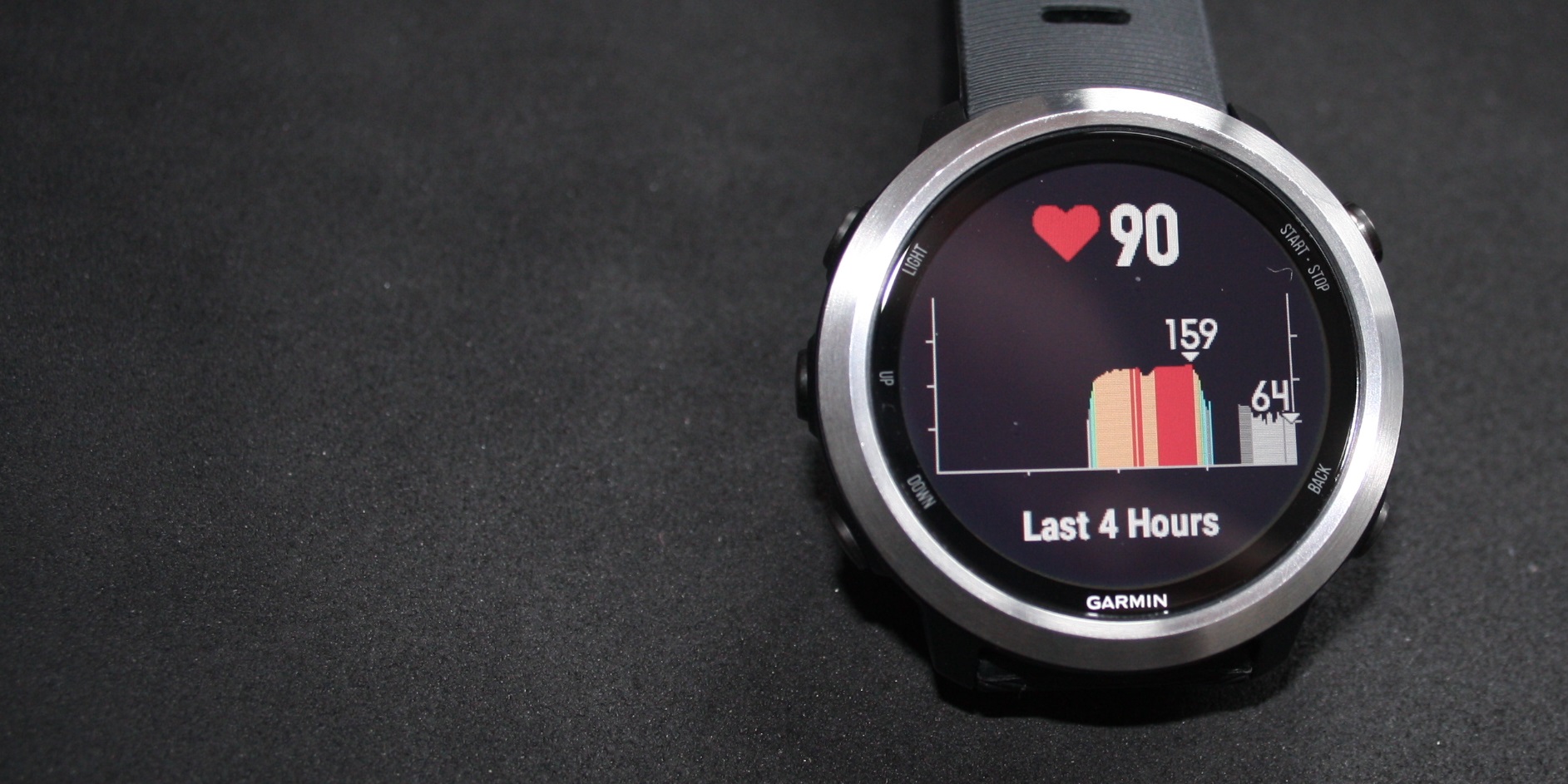
Again I could present a case for the 645’s optical HR being RUBBISH or BRILLIANT. I’ve just said my piece, so these charts are provided to be illustrative of what you can expect FROM ANY OPTICAL HR DEVICE ON THE WRIST.
Here are 90 minutes of steady-state running. The blue line is the chest strap and presumably correct. The 645 does well and even the STRATOS does alright despite two periods of notably low readings. I’d take that result from the 645.
Here we have another hour of steady state running but with a couple of sustained periods with higher HRs into the 150s/160s and a stop for a quick chat with someone at 20 minutes. This was a bad day at the office all round. The blue (HRM-TRI) and green (optical, Polar OH1) should both be correct. At the start it’s likely that the chest strap is wrong (it’s my original HRM-TRI and on its 3rd battery). The STRATOS is just plain wrong. After the ‘chat’ period the 645 struggles, regains confidence and then goes off on a tangent to some place more interesting than where I was running. The Polar OH1 wins here. For this sort of run I’d expect the 645 would give normally better results…but, hey, this is what it was like.






In summary, the 645’s optical HR wasn’t great but it was fine for steady-state running.
Indeed, on reflection, this was a slightly worse performance with the 645 than with the exact same Elevate sensor on the 935 and Vivoactive 3. So maybe I had a bad unit?
If you buy the 645 and expect the performance I have shown above, let’s hope you will experience better. At least I have prepared you for a plausible ‘not awesome’ scenario.
Elevation & Elevation Accuracy
My understanding from research for this Garmin 645 Review is that the Forerunner 645 gets two GPS fixes. The first is a 2D fix when the green circle has completed around the display. That’s when you normally start running. However a 3D fix is obtained 20-30 seconds later. This then sets the altitude by GPS. From that point changes in atmospheric pressure measured by the onboard barometer give you elevation changes. I’m not 100% sure but I do NOT think that any further 3D GPS altitude fixes are made during your workout. Prior to April 2018 this was not working properly but is now fixed (not tested by me).
Hence you may experience elevational drift if the weather (air pressure) changes.
Other Garmin watches allow a manual setting of a known elevation and an automatic setting at a known GPS point and at POIs. So I think it is a mistake not to at least allow a manual setting on the 645.
Please let me know if any of that is incorrect
Below I have compared some elevation performances to a GPS-corrected altimetry profile that you can assume to be correct (red). I did NOT calibrate the devices at the start for the current location, this explains the differing start heights. So we should get parallel lines…which we almost do.
All the devices show some drift over the 3 hours, probably due to changes in air pressure from changes in the weather. Apart from the STRATOS these show usable results (for me). If altimetry is important to you then this partly indicates the need for some degree of GPS- and barometric-altimetry combination to avoid drift. Suunto does that.
Running With Power
This is one area of running that developed a lot in 2017 and will continue to do so over the next few years. Essentially a running power meter is a proxy for effort. Theoretically, your best effort will come from an evenly paced run with equal efforts uphill and downhill. It’s cool. I use it. It’s not perfect but has its uses and cyclists love it as the techy cyclists already have proper power meters on their bikes – albeit they work differently.
But you need more kit to take advantage of this.
The cheapest way is with an HRM-RUN chest strap that supports Running Dynamics. The HRM-TRI or RD-POD will be cool as well. A properly calibrated footpod will further improve accuracy and hence usefulness. If you already have that hardware then go forth and download Garmin’s free Running Power app. Be wary of the accuracy of the inputs from your sensors. Rubbish In…Rubbish…well, you know the rest.
Taking it more seriously you’d go for either RunScribe or STRYD. More options may emerge in 2018, indeed I HOPE Garmin do one. There are LOTS of resources on this site about the Running With Power devices and apps. I’ll link to some in a minute but this table is a good place to start.

Garmin 645 + Runscribe
Garmin 645 + STRYD
STRYD Review, 2000 Mile Update – Running Power – 2021’s Best Footpod Meter
Garmin 645 + Garmin Running Power
Power Dropouts on the 645?
A: No
At the time of writing this Garmin 645 Review, RunScribe’s power metric is still in beta. Comparison of power levels is NOT a sensible thing to do right now. I am showing you two comparative charts but that’s just to show that the recent connectivity issues do not affect my 645.
These charts also show you lots of CIQ-cleverness. A 3rd party app (data field) creates its own data and this data is automatically passed through to Garmin Connect and some 3rd party analysis tools.
There is a mildly annoying limit of 2 data fields, although each 3rd party data field can contain LOTS of 3rd party data. ie I could not compare Garmin Running Power, STRYD and RunScribe at the same time (with this method, there are ways… 😉 ) But as you can see RunScribe creates LOTS of interesting gait metrics.
One significant issue with some Fenix 5 devices has been poor connectivity to various sensors. Those connectivity issues do not seem to happen on the all-plastic Forerunner 935 maybe it’s the metal in the Fenixes? Which could be an issue as the Forerunner 645 Music most definitely has a metal bezel – apparently, it seems NOT to be an issue.
Firstbeat Goodies
You get all of this clever stuff from Firstbeat thrown in. And it is clever. Be mindful that optical HR from the wrist might cause issues with the data that Firstbeat has to deal with. This should be rectified by a chest strap and most newish chest straps should also produce HRV data that some of the Firstbeat algorithms need in any case. FWIW I always wear a Garmin HRM-TRI chest strap, the HRM-RUN is perfectly fine if you just run.
I’ll talk a bit more about some of these features below and this section of the content is co-authored by HB at Firstbeat.

Forerunner 645 and VO2max in the Garmin 645 Review
A higher VO2max makes sport AND THE PHYSICAL RIGOURS OF LIFE easier. Sometimes us sporty people forget that.

It’s a relatively definitive metric of fitness. Improving it should indicate you are potentially faster but it does not take into account the economy of your technique so we could both have a VO2max of 60 but if your running gait is more efficient than mine then it’s likely you’ll beat me in a 5k.
Maintaining your VO2max can also reduce the physiological impact of stress, makes it easier to recover, and can help stave off the effects of ageing.
You can’t generally do anything with VO2max. It’s a marker of your progression.
- Firstbeat Factette: The first Garmin Device with VO2max detection was the Forerunner 620 (2013)
Forerunner 645 and Performance Condition
Like the analysis behind VO2max, Performance Condition (PC) looks at the relationship between your running speed and heart rate. You are sometimes prompted with your PC about 5 or 6 minutes into a run but you can also display it continuously as a data metric and/or analyse it afterwards.

Here we have a long Z2/Z3 hour bike ride (based on power meter data) following a swim. I’m not sure if this is how a Performance Condition chart is meant to be. 4 hours seem to mark a turning point in performance as fatigue sets in. Maybe there is an extended post-swim adjustment & ‘warming up period’ ??

- Firstbeat Factette: The first Garmin device with Performance Condition was the Forerunner 630 (2015)
Forerunner 645 and Aerobic Training Effect
The two Training Effect metrics are important and, in my experience, they seem to reflect well the session I’ve just completed. The further away from race day you are and the longer your race is to be then the more important AEROBIC training effect is. Typically you will see the effect from the whole workout at the end of the workout and the screens, shown below, will also be stored in your workout history on the watch.
To progress and improve, you need to challenge yourself in the right way and at the right level. Aerobic Training Effect analyzes your performance to reveal the impact of your activity on the development of your cardio-respiratory system. The fitter and more active you are, the harder you need to work to improve. Behind the scenes, your watch takes this information into account to ensure that the Aerobic Training Effect feedback you get always reflects your own personal situation. Note: prior to the introduction of Anaerobic Training effect in 2017, Aerobic Training Effect was simply called Training Effect.
- Firstbeat Factette: The first Garmin device with (Aerobic) Training Effect was the Forerunner 610 (2011, TE)
Forerunner 645 and Anaerobic Training Effect
A powerful metric, this analysis reveals the impact of your activity on the development of anaerobic performance capacity. A lot of the confusion surrounding Anaerobic Training Effect comes from the fact that it doesn’t necessarily have much to do with how much time you spend in what some people refer to as the anaerobic heart rate zone. Instead, Anaerobic Training Effect is designed to accumulate when you challenge yourself with sustained bursts of intense effort interspersed with lower intensity efforts that give your body a chance to recover. HIIT sessions are a great way to register a higher Anaerobic Training Effect score, especially when the intervals performed focus on efforts in excess of your VO2max.
- Firstbeat Factette: The first Garmin device with Anaerobic Training Effect was the Fenix 5 (2017)
Forerunner 645 and Training Load
If you trained with me then, for sure, I would be looking at your Training Load (TL). It’s important. Whilst TL is still more complex than that presented by the Firstbeat metric, this is a great place to start.
Long runs, tempo runs, intervals, cycling, going to the gym? Mix things up, it doesn’t matter. Training Load reveals the combined physiological impact of all your activities in the past 7 days.
What are the numbers? Your Training Load is simply the sum of the EPOC values of your activities. EPOC is used to describe homeostasis disturbance and when placed into the context of your fitness level (VO2max) and activity history also provides the basis for your Training Effect. In the world of elite sport, sports scientists are increasingly turning to this type of training load data to help athletes reduce injuries through smart application of load over time.
- Firstbeat Factette: Training load for cycling requires a power meter.
- Firstbeat Factette: The first Garmin devices with Training Load were the Fenix 5 & Forerunner 935 (2017)
Forerunner 645 and Training Status
This popular feature combines the insights of Training Load and VO2max to reveal the relationship between your activities and your personal fitness level. The feedback it offers gives you the ability to evaluate the effectiveness of your programs and routines, understand where you are in a training cycle, and learn how your body responds.
If you are following a proper training plan geared towards a specific race then Training Status may be a good check of how well the plan is working for you.
If ‘Peaking’ unexpectedly appears, get down to your local parkrun promptly and run really fast 😉
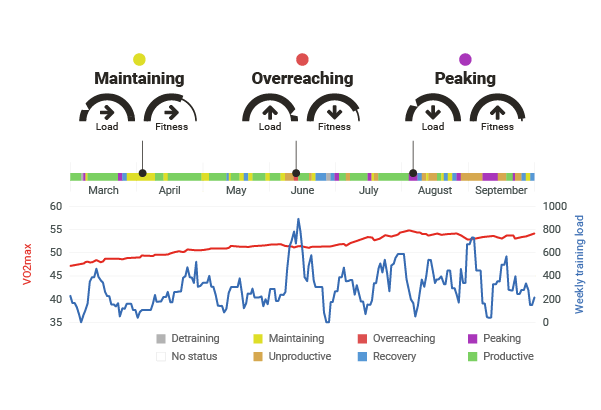
- Firstbeat Factette: The first Garmin devices with Training Status were the Fenix 5 & Forerunner 935 (2017)
Forerunner 645 and Recovery Time Advisor

I don’t treat this measure as the ‘truth’ but I certainly take it into account when training frequently.
This will usually pop up at the end of your run. It will NOT be stored in your workout history as, for example, one hour later it will have changed. So you can see several of the Firstbeat metrics here Middle Left Button>>Press Start Button on Training Status>>Scroll Through Options
- Firstbeat Factette: The first Garmin device with Recovery Time was the Forerunner 620 (2014)
Forerunner 645 and Lactate Threshold
The only training metric onboard the FR645 that absolutely requires that you have your watch paired with a chest-belt, this feature uses Heart Rate Variability data captured across a range of intensities to identify your lactate threshold. Your lactate threshold responds to training, meaning you can improve it by challenging yourself in the right way. Once your device has detected your lactate threshold, you have a chance to use this information to personalize your heart rate zones based to match your personal situation.
You will get a Lactate Threshold heart rate AND and Lactate Threshold pace. If you are not so fit then you might be able to maintain this for about 40 minutes but the fitter you get the longer you can maintain it for ie WELL over an hour. For me, it’s not quite my half marathon pace if I only run-trained I reckon it would be my HM pace.
- Firstbeat Factette: The first Garmin device with Lactate Threshold was the Forerunner 735xt (2016)
Forerunner 645 and All-day Stress and Recovery
Stress can be something of a mystery, but it doesn’t have to be. The FR645 features a special heart rate variability-based analysis capable of revealing the presence and intensity of the stress you experience. Checking in with this feedback will allow you to pinpoint activities, interactions, and events that produce stress in your life.
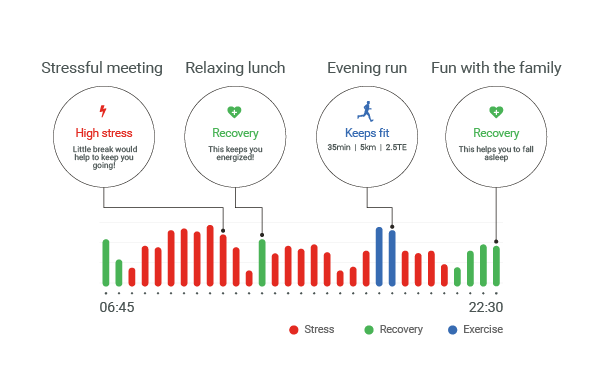
You can also see when your body is in a state of rest and recovery. This can be particularly important when looking at your overnight stress data, which will shed some light into the restorative quality of your sleep. When examining this feedback, it’s essential to understand that stress isn’t necessarily a bad thing, and experiencing stress is an important part of life. The key is to ensure that stress is offset with adequate recovery, and maintaining this balance between stress and recovery is vital to being able to benefit from the challenges you experience in life and through your activities.
- Firstbeat Factette: The first Garmin device with All-day Stress & Recovery was the Vivosmart 3 (2016)
Forerunner 645 Race Predictor
There are various race predictors online which can extrapolate your performance at one distance to another. Just because you got a 5k PB with lots of anaerobic training does NOT mean that you will be able to anywhere near achieve a race predictor’s time for a marathon. I’m not sure exactly how Garmin’s race predictor works. I’ve been doing longer stuff recently.

Links & Bugs Unearthed In this Garmin 645 Review
In this Garmin 645 Review, I do not systematically ‘test’ any device despite using the word ‘test’ quite a lot.
Firmware 2.50 (April 2018) seems generally robust and I have no specific issue with it. Because of the nature of headphones, there will always be 3rd party, vendor-specific issues there just like with other watch manufacturers. I am keenly watching out for connectivity issues. Another premium Garmin device with these issues will be awful.
- Garmin Forums: Here (link to garmin.com)
- Garmin 645 Changelog: Here 645M (link to garmin.com) and here 645 (link to garmin.com)
- Garmin 645 Manual: Here (link to:garmin.com)
- There seems to be a bug with my device meaning I can only connect to a computer as an MTP device. Meaning the 645 never appears as a windows drive. Grrrr. Garmin advised returning the device.
- Others report issues with requiring to wear the watch on the same side as the controls for your headphones.
Price, Availability & Discounts
Hopefully, you found this review useful. Longer reviews like this take about a week to produce and I have a day job that pays the bills.
The Forerunner 645 Music is available NOW
armin discourages discounting of new products to any notable amount. The Amazon deal may well be a good choice for most of the year and you can always easily send it back if you have problems.
Summary Points
In this Garmin 645 Review, we have found, once again, that Garmin has produced a most amazingly complete Forerunner watch full of every imaginable option. Once again the sensors (GPS, oHR) let the overall package down and should act as somewhat of a deterrent to non-casual runners looking for an element of precision in their training. For those of you willing to augment the 645 with chest strap and footpod purchases then those inbuilt sensor issues will go away.
I’d be keen to upgrade away from a 630’s touchscreen to something like the 645. Yet I’m not so sure I would upgrade from the Forerunner 230/235 if I just wanted a plain and simple running watch. The 235 is perfectly fine for that purpose; keep the 230/235 as a running watch and buy a prettier watch/band to wear the rest of the time.
I’ve somewhat lamented the 645’s looks but aesthetics are a personal choice. Rest assured that your 645 will do LOTS of sporty things that watches of your friends can’t.
The key USPs for the 645 are the smaller size format and Music. If either of those factors are REALLY important to you then you will find it hard to beat the 645. These are the two factors that will make this device a success.
Garmin Pay might become practical for many later in 2018. The MUSIC link-ups with iHeartRadio and Deezer will be welcomed but, let’s face, we all want Spotify in Europe. Well, I do.
Sure the oodles of functionality are attractive as well BUT personally, I would err towards the larger Forerunner 935 (not the Fenix 5S, 5X or 5, they have issues) and the better battery life that comes with it. If you are ever planning to do any multisports or even just swim or cycle a bit more seriously then the 935 is the one to go for. I DO recommend the 935+additional sensors but I’m somewhat neutral overall on the 645. Hopefully, you’ve read the sections of the review that are important to you and that should swing you either towards or from, a BUY decision.








